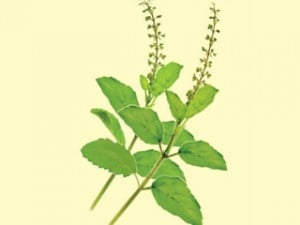
‘Tulsi is a sacred plant which grows to a height of 2-3 feet. There are two varieties – black (Krushṇa) and white. This plant has vertically branching foot-stalks which bears small flowers. Most probably, its root name is tuḷas, and Tulsi is its Sanskrut version.
नरा नार्यश्च तां दृष्ट्वा तुलनां दातुमक्षमाः ।
तेन नाम्ना च तुलसी तां वदन्ति पुराविदः ।।
– Brahmavaivartapuraṇ, Khanḍa 2, Adhyaya 15
Meaning : Man saw this plant; but could not compare it with any other plant. Hence, archaeologists began calling it Tulsi.
Worship of Shri Krushna without Tulsi leaves is in vain, because Shri Krushna does not partake of an offering offered without Tulsi leaves or food offered without sprinkling water on it with Tulsi leaves.
Looking at, touching, meditating upon, praying to, worshipping, planting or eating Tulsi leaves can cleanse of sins committed in many past births. It is said that all Deities reside in this plant right from the roots to its stalks.’
Why are Tulsi leaves offered to Shri Krushna ?
We are told in a simple language that ‘a specific substance offered to a specific Deity is the favourite of that Deity’; for example, Shri Gaṇapati likes red flowers, Shiva bel (Aegle marmelos tree) leaves and Shri Krishna Tulsi. Then a story to explain why that Deity likes that specific substance is narrated. In reality, superior Deities like Shiva, Shrivishṇu, Shri Gaṇapati do not have any likes or dislikes. The reason for offering specific substances to specific Deities is as given ahead.
One of the objectives of worship is to charge the Idol with Chaitanya (Divine consciousness), so that it assists in our spiritual progress. So as to generate that Chaitanya, the substance offered to that Idol has more ability
to attract the pavitraks (Subtlemost particles of Chaitanya) of that Deity, from as far as the Maharlok, when
compared with other substances. Red flowers have the ability to attract the pavitraks of Shri Gaṇapati, bel of Shiva, Tulsi of Shri Krushna etc. Hence, Tulsi leaves are offered to Shri Krushna.
A Tulsi is planted in tulsi-vrundavan (A small rectangular structure in which the Tulsi [Holy basil plant] is grown) in front of the house; and Tulsi is even wedded to Shri Krushṇa.
Symbol of vairagya (Detachment)
A Tulsi plant symbolises detachment. Once when performing the ritual of tula (Weighing with food grain, gems etc.) of Shri Krushṇa, despite placing diamonds, precious stones, gold etc. in one pan, the other pan with Shri Krushṇa seated on it just did not move. Finally, only after a Tulsi leaf was placed on all the wealth by Rukmini did the weighing scale balance. Through this incident, Shri Krushṇa taught that He could be won over only with
detachment and not with wealth. Hence, phrases like ‘Placing Tulsi leaves on the house’ depicts sacrificing the house.
Subtle characteristics of Tulsi leaves
Source : Sanatan’s Granth, ‘Shrivishnu, Shriram and Shrikrushna‘


